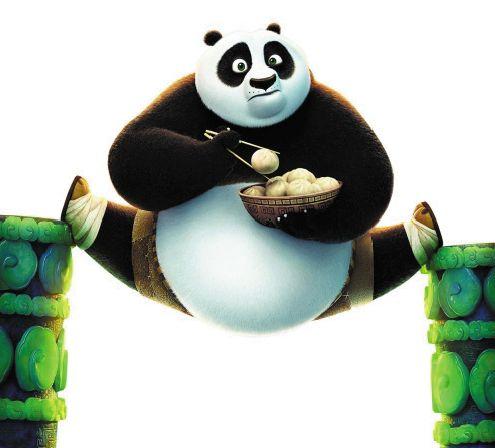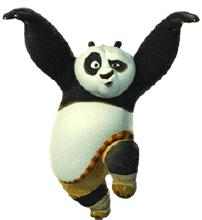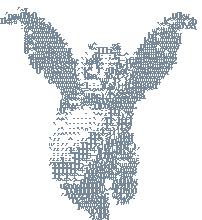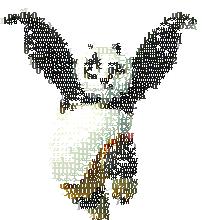字符画是一种由字母、标点或其他字符组成的图画,它产生于互联网时代,在聊天软件中使用较多,本文我们看一下如何将自己喜欢的图片转成字符画。
静态图片
首先,我们来演示将静态图片转为字符画,功能实现主要用到的 Python 库为 OpenCV,安装使用 pip install opencv-python 命令即可。
功能实现的基本思路为:利用聚类将像素信息聚为 3 或 5 类,颜色最深的一类用数字密集度表示,阴影的一类用横杠(-)表示,明亮部分用空白表示。
主要代码实现如下:
def img2strimg(frame, K=5): if type(frame) != np.ndarray: frame = np.array(frame) height, width, *_ = frame.shape frame_gray = cv2.cvtColor(frame, cv2.COLOR_BGR2GRAY) frame_array = np.float32(frame_gray.reshape(-1)) criteria = (cv2.TERM_CRITERIA_EPS + cv2.TERM_CRITERIA_MAX_ITER, 10, 1.0) flags = cv2.KMEANS_RANDOM_CENTERS # 得到 labels(类别)、centroids(矩心) compactness, labels, centroids = cv2.kmeans(frame_array, K, None, criteria, 10, flags) centroids = np.uint8(centroids) # labels 的数个矩心以随机顺序排列,所以需要简单处理矩心 centroids = centroids.flatten() centroids_sorted = sorted(centroids) # 获得不同 centroids 的明暗程度,0 为最暗 centroids_index = np.array([centroids_sorted.index(value) for value in centroids]) bright = [abs((3 * i - 2 * K) / (3 * K)) for i in range(1, 1 + K)] bright_bound = bright.index(np.min(bright)) shadow = [abs((3 * i - K) / (3 * K)) for i in range(1, 1 + K)] shadow_bound = shadow.index(np.min(shadow)) labels = labels.flatten() # 将 labels 转变为实际的明暗程度列表 labels = centroids_index[labels] # 解析列表 labels_picked = [labels[rows * width:(rows + 1) * width:2] for rows in range(0, height, 2)] canvas = np.zeros((3 * height, 3 * width, 3), np.uint8) # 创建长宽为原图三倍的白色画布 canvas.fill(255) y = 8 for rows in labels_picked: x = 0 for cols in rows: if cols <= shadow_bound: cv2.putText(canvas, str(random.randint(2, 9)), (x, y), cv2.FONT_HERSHEY_PLAIN, 0.45, 1) elif cols <= bright_bound: cv2.putText(canvas, "-", (x, y), cv2.FONT_HERSHEY_PLAIN, 0.4, 0, 1) x += 6 y += 6 return canvas原图如下:

效果图如下:

GIF 动图
接下来我们演示将 GIF 转为字符画,功能实现主要用到的 Python 库为 imageio、Pillow,安装使用 pip install imageio/Pillow 命令即可。
功能实现的基本思路如下:
将 gif 图片的每一帧拆分为静态图片
将所有静态图片变为字符画
将所有字符画重新合成 gif
主要代码实现如下:# 拆分 gif 将每一帧处理成字符画 def gif2pic(file, ascii_chars, isgray, font, scale): ''' file: gif 文件 ascii_chars: 灰度值对应的字符串 isgray: 是否黑白 font: ImageFont 对象 scale: 缩放比例 ''' im = Image.open(file) path = os.getcwd() if(not os.path.exists(path+"/tmp")): os.mkdir(path+"/tmp") os.chdir(path+"/tmp") # 清空 tmp 目录下内容 for f in os.listdir(path+"/tmp"): os.remove(f) try: while 1: current = im.tell() name = file.split('.')[0]+'_tmp_'+str(current)+'.png' # 保存每一帧图片 im.save(name) # 将每一帧处理为字符画 img2ascii(name, ascii_chars, isgray, font, scale) # 继续处理下一帧 im.seek(current+1) except: os.chdir(path) # 将不同的灰度值映射为 ASCII 字符 def get_char(ascii_chars, r, g, b): length = len(ascii_chars) gray = int(0.2126 * r + 0.7152 * g + 0.0722 * b) return ascii_chars[int(gray/(256/length))] # 将图片处理成字符画 def img2ascii(img, ascii_chars, isgray, font, scale): scale = scale # 将图片转换为 RGB 模式 im = Image.open(img).convert('RGB') # 设定处理后的字符画大小 raw_width = int(im.width * scale) raw_height = int(im.height * scale) # 获取设定的字体的尺寸 font_x, font_y = font.getsize(' ') # 确定单元的大小 block_x = int(font_x * scale) block_y = int(font_y * scale) # 确定长宽各有几个单元 w = int(raw_width/block_x) h = int(raw_height/block_y) # 将每个单元缩小为一个像素 im = im.resize((w, h), Image.NEAREST) # txts 和 colors 分别存储对应块的 ASCII 字符和 RGB 值 txts = [] colors = [] for i in range(h): line = '' lineColor = [] for j in range(w): pixel = im.getpixel((j, i)) lineColor.append((pixel[0], pixel[1], pixel[2])) line += get_char(ascii_chars, pixel[0], pixel[1], pixel[2]) txts.append(line) colors.append(lineColor) # 创建新画布 img_txt = Image.new('RGB', (raw_width, raw_height), (255, 255, 255)) # 创建 ImageDraw 对象以写入 ASCII draw = ImageDraw.Draw(img_txt) for j in range(len(txts)): for i in range(len(txts[0])): if isgray: draw.text((i * block_x, j * block_y), txts[j][i], (119,136,153)) else: draw.text((i * block_x, j * block_y), txts[j][i], colors[j][i]) img_txt.save(img) # 读取 tmp 目录下文件合成 gif def pic2gif(dir_name, out_name, duration): path = os.getcwd() os.chdir(dir_name) dirs = os.listdir() images = [] num = 0 for d in dirs: images.append(imageio.imread(d)) num += 1 os.chdir(path) imageio.mimsave(out_name + '_ascii.gif',images,duration = duration)原图如下:

黑白效果图如下:

彩色效果图如下:

总结
本文我们利用 Python 演示了将静态图和 GIF 转为字符画的方法,大家如果有兴趣的话,可以将自己喜欢的图转一下,如果对转换效果不满意,还可以修改代码,改成自己满意的效果。
示例代码:py-ascii
以上就是Python 实现图片转字符画的示例(静态图片,gif皆可)的详细内容,更多关于python 图片转字符画的资料请关注python博客其它相关文章!
-
<< 上一篇 下一篇 >>
Python 实现图片转字符画的示例(静态图片,gif皆可)
看: 1208次 时间:2020-11-30 分类 : 数据分析
- 相关文章
- 2021-12-20python数据挖掘使用Evidently创建机器学习模型仪表板
- 2021-12-20Python多进程共享numpy 数组的方法
- 2021-12-20python数据分析近年比特币价格涨幅趋势分布
- 2021-12-20python调用matlab的方法详解
- 2021-12-20python学习与数据挖掘应知应会的十大终端命令
- 2021-07-20pandas中NaN缺失值的处理方法
- 2021-07-20Python数据分析入门之数据读取与存储
- 2021-07-20Python 如何读取字典的所有键-值对
- 2021-07-20如何获取numpy的第一个非0元素索引
- 2021-07-20Python机器学习之KNN近邻算法
-
搜索
-
-
推荐资源
-
Powered By python教程网 鲁ICP备18013710号
python博客 - 小白学python最友好的网站!